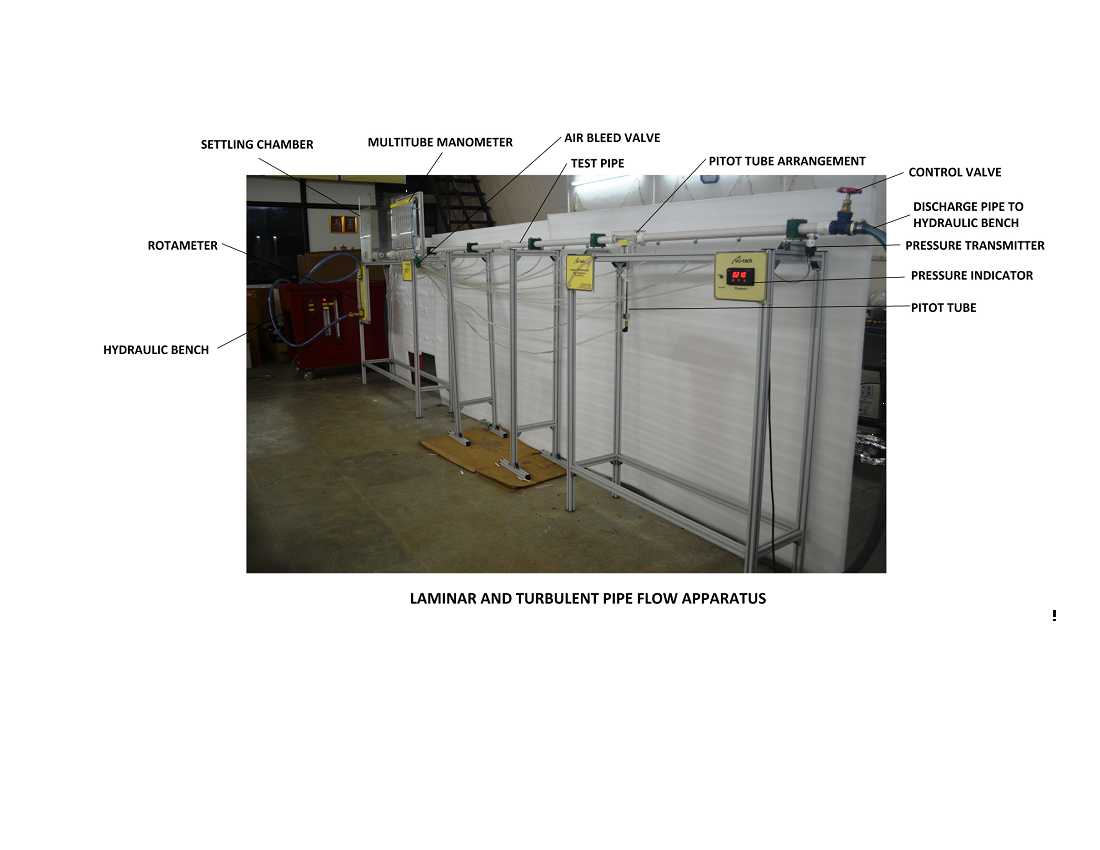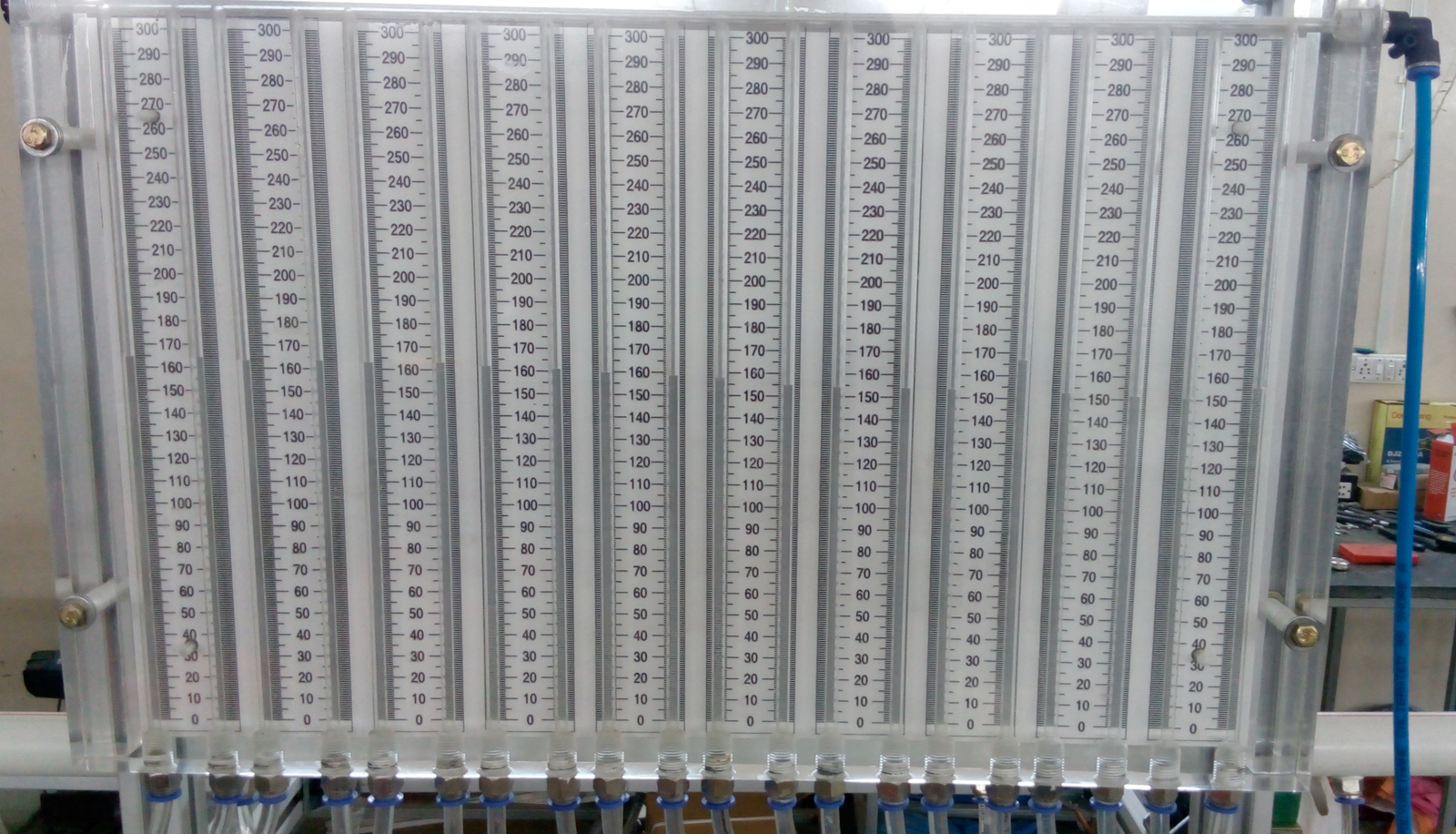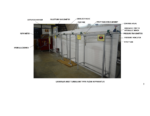Fluid Mechanics: Laminar and Turbulant Pipe Flow Apparatus MODEL GFM 29
Sci-tech Laminar and Turbulent Pipe Flow Apparatus Model GFM 29 is a floor mount unit and has been designed to demonstrate laminar and turbulent pipe flows over a wide range of flow conditions. The apparatus has been designed to enable students to measure loss of pressure head in pipes at various flow velocities or Reynolds numbers. The geometry and flow parameters have been selected to enable studies in the ranges of practical interest. The apparatus is mounted on a supporting table on wheels and is designed for use with the FM 100 Hydraulic Bench or any other suitable controlled water supply and recirculation system. The apparatus consists of settling chamber and bell mouth entry. The settling chamber has screens to damp any disturbances in the flow. The passage of flow through the settling chamber and the bell mouth entry ensures minimum flow disturbance at the pipe entry. Flow velocity in the pipe or Reynolds number can be varied using flow control valves and laminar and turbulent pipe flow can be obtained. Static pressures along the pipe wall are measured using pressure tapings at regular intervals. Mean flow velocity profile is measured using a Pitot tube traversed by a micrometer. Flow velocity is measured using variable area flow meter and the measuring tank of the Hydraulic Bench. Pressures are measured using multi- tube water manometer and digital pressure meter. All components of apparatus are manufactured using corrosion resistant materials.
Study of any fluid flow problem depends upon the laminar, transitional or turbulent nature of the fluid flow. Laminar flow is important because of reduced wall friction, pressure losses and pumping power. It is difficult to maintain laminar flow at higher Reynolds numbers. Understanding of the laminar and turbulent flows is important for students of fluid mechanics, hydraulics and related areas in science and technology. Sci-tech Laminar And Turbulent Pipe Flow Apparatus Model GFM 29 is an important experimental set-up for any Fluid Mechanics and Hydraulics Laboratory of an educational institution.
The Sci-tech Laminar and Turbulent Pipe Flow Apparatus Model GFM 29 is a floor mount unit and has been designed to demonstrate laminar and turbulent pipe flows over a wide range of flow conditions. The apparatus has been designed to enable students to measure loss of pressure head in pipes at various flow velocities or Reynolds numbers. The geometry and flow parameters have been selected to enable studies in the ranges of practical interest. The apparatus is mounted on a supporting table on wheels and is designed for use with the FM 100 Hydraulic Bench or any other suitable controlled water supply and recirculation system. The apparatus consists of settling chamber and bell mouth entry. The settling chamber has screens to damp any disturbances in the flow. The passage of flow through the settling chamber and the bell mouth entry ensures minimum flow disturbance at the pipe entry. Flow velocity in the pipe or Reynolds number can be varied using flow control valves and laminar and turbulent pipe flow can be obtained. Static pressures along the pipe wall are measured using pressure tapings at regular intervals. Mean flow velocity profile is measured using a Pitot tube traversed by a micrometer. Flow velocity is measured using variable area flow meter and the measuring tank of the Hydraulic Bench. Pressures are measured using multi- tube water manometer and digital pressure meter. All components of apparatus are manufactured using corrosion resistant materials.
The Sci-tech Laminar and Turbulent Pipe Flow Apparatus Model GFM 29 Demonstration Apparatus is an important experimental set-up for any Fluid Mechanics and Hydraulics Laboratory of an educational institution
OPTION:
‘Sci-Cal’ Computer Control Software & Interface in ‘LabVIEW’ Computer based learning software can be included to enable students understand and conduct experiments, tabulate results and plot graphs.
- Pipe, PVC, 20mm diameter bore and 4m long, mounted horizontally on rigid supports.
- Settling chamber (Perspex) with flow smoothening screens (3 Nos.)
- Bell mouth entry (parabolic contour).
- Return pipe.
- Adjustable flow control and bypass valves.
- Static pressure tappings: (Total: 20), 18 along pipe (equally spaced), one in settling chamber, one for Pitot probe.
- Pitot tube and Micrometer assembly with mountings to measure velocity profiles.
- Digital pressure meter, 1kPa (gauge)
- Multi-tube water manometer, 20 tubes, 50mm long.
- Variable area flow meter.















